Los tipos de comunicación son diferentes maneras en las que comunicamos mensajes a otras personas.
Para poder entender cómo puedes comunicar eficazmente, primero necesitas entender qué tipos de comunicación tienes a tu disposición para transmitir e interpretar pensamientos e ideas.
Los 4 tipos básicos de comunicación que podemos usar son:
- Comunicación verbal,
- Comunicación escrita,
- Comunicación no verbal, y
- Comunicación visual.
Analizaremos cómo estos cuatro tipos de comunicación se ramifican en varios subtipos y cómo te ayudan a mejorar tus habilidades comunicativas al explicar este proceso bidireccional en detalle. Esto, a su vez, te ayudará a transmitir e interpretar información fácilmente en el trabajo.
Pero antes de profundizar en todo esto, necesitamos analizar una clasificación que afecta a cualquier tipo de comunicación que puedas realizar.
¡Empecemos!

Comunicación sincrónica vs. asincrónica
Antes de profundizar en las explicaciones de los cuatro tipos principales de comunicación, debemos asegurarnos de que todos comprendamos qué es la comunicación sincrónica y asincrónica.
Una forma de distinguir los tipos de comunicación es analizar el momento en que se comunica la información y el momento en que se recibe. Al analizar la comunicación de esta manera, podemos clasificarla en dos grupos — sincrónica y asincrónica.
Comunicación sincrónica
Si la conversación en la que participas es sincrónica, esto significa que está sucediendo en tiempo real.
En otras palabras, todas las partes involucradas en el proceso de comunicación toman turnos simultáneamente en el intercambio de información.
Ejemplos de comunicación sincrónica incluyen:
- Reuniones en vivo — por ejemplo, los miembros de equipo se reúnen en la misma ubicación para realizar una reunión diaria,
- Llamadas de audio — por ejemplo, dos miembros de un equipo hablan sobre su proyecto a través el teléfono o una aplicación de mensajería empresarial,
- Videollamadas — por ejemplo, los miembros de equipo usan una solución virtual con funcionalidades de vídeo para realizar reuniones diarias, y
- Mensajes instantáneos — por ejemplo, dos miembros de un equipo usan una aplicación de comunicación empresarial para hablar sobre un proyecto actual.
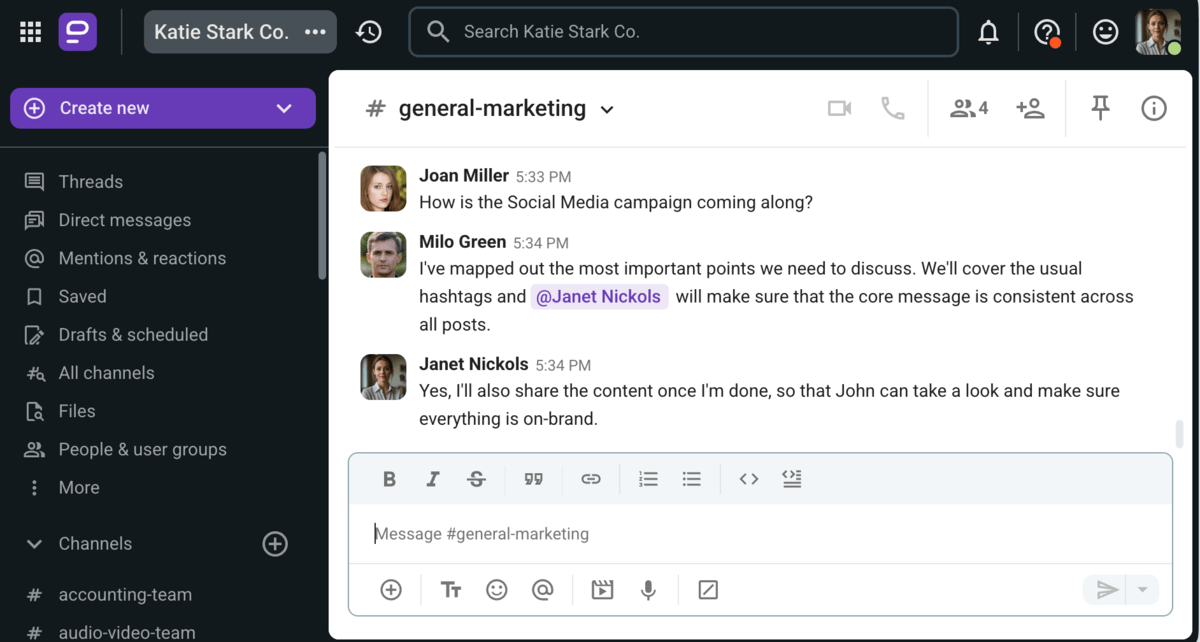
Mejora la comunicación de tu empresa con Pumble
Comunicación asincrónica
Si la conversación en la que participas es asincrónica, las partes involucradas en el intercambio no están participando en la conversación al mismo tiempo.
Esto es algo común con equipos remotos cuyos miembros operan en diferentes zonas horarias, y que por lo tanto tienen horas laborales diferentes.
Ejemplos de comunicación asincrónica incluyen:
- Vídeos pregrabados — por ejemplo, un vídeo de incorporación que se presenta a los nuevos empleados de una empresa.
- Mensajes directos (DM) — cuando una persona envía un mensaje y la otra responde más tarde, según su conveniencia o disponibilidad.
- Mensajes programados — mensajes escritos con antelación para que lleguen en un momento específico.
Con esta clasificación de comunicación cubierta, podemos pasar a los cuatro tipos principales de comunicación.
🎓 Consejo Pro de Pumble
El profesional moderno a menudo usa ambos estilos de comunicación. Para aprender más sobre cómo los dos estilos coexisten, consulta este artículo:
Los 4 tipos principales de comunicación
Como se mencionó, los 4 tipos principales de comunicación son:
- Comunicación verbal,
- Comunicación escrita,
- Comunicación no verbal, y
- Comunicación visual.
Cada uno de ellos implica diferentes métodos de comunicación y requiere diferentes habilidades comunicativas.
Explicaremos:
- Las diferentes maneras de utilizar estos tipos de comunicación de forma eficiente,
- Consejos para mejorar tu enfoque, y
- Los errores que debes evitar en cada uno.
Tipo 1: Comunicación verbal
Según la definición de Andrea McDuffie, la comunicación verbal incluye cualquier comunicación que usa la lengua hablada como manera de compartir la información intencionalmente.
Es usualmente un tipo sincrónico de comunicación. La excepción serían los oradores que graban sus mensajes como llamadas de audio o vídeo y los mandan a otros. En estos casos, nos referimos a la comunicación verbal como asincrónica.

Existen muchos modelos de comunicación que se pueden utilizar para diseccionar el tipo de comunicación verbal, pero los principales elementos de este tipo de intercambio son:
- El mensaje, por ejemplo una parte de información que alguien quiere compartir,
- El remitente, por ejemplo la persona que inicia la conversación para poder compartir esta mensaje (al “codificarlo” desde el pensamiento hasta las palabras habladas),
- El receptor, por ejemplo la persona que necesita entender esta mensaje (al “decodificarlo” desde palabras escuchadas al pensamiento),
- El ruido, por ejemplo las interferencias que puede ocurrir para obstaculizar la comunicación entre el emisor y el receptor, y
- El feedback, por ejemplo la respuesta que el receptor tiene sobre la nueva información, dependiendo de cómo esta nueva información fue entendida e interpretada.
Considerando que el clave de la comunicación verbal es la lengua hablada y que diferentes países hablan diferentes lenguas, el conocimiento de al menos una lengua que no es lengua nativa es importante para el entendimiento intercultural.
Esto es crucial para equipos cuyos miembros hablan diferentes idiomas. Según las Estadísticas de comunicación en el lugar de trabajo de Pumble de 2025, los 10 idiomas empresariales más utilizados a nivel mundial en situaciones interculturales (clasificados según su porcentaje en el PIB mundial) son:
- Inglés, con un 27%,
- Chino, con un 18%,
- Español, con un 8%,
- Japonés, con un 6%,
- Alemán, con un 5%,
- Francés, con un 4%,
- Árabe, con un 3%,
- Italiano, con un 2%,
- Portugués, con un 2%, y
- Coreano, con un 2%.
Según el contexto de la comunicación verbal, existen varios tipos. Cada uno se utiliza en circunstancias diferentes y, por lo tanto, requiere un enfoque ligeramente distinto.
Tipos de comunicación verbal
Existen 5 tipos principales de comunicación verbal:
- Comunicación intrapersonal — las conversaciones silenciosas que mantenemos con nosotros mismos,
- Comunicación interpersonal uno a uno — una conversación individual entre dos personas,
- Comunicación en grupos pequeños — comunicación interpersonal que se desarrolla entre más de dos personas;
- Comunicación pública — una persona (o un grupo de personas) que comparte información con otro grupo; y
- Comunicación verbal masiva — el proceso de enviar y recibir mensajes de audio o vídeo a través de medios como periódicos, televisión, programas de radio, comunicados en internet, etc.
Cada uno de estos tipos de comunicación verbal tiene sus propias reglas.
Prueba Pumble para una mejor comunicación en equipo
Consejos para una mejor comunicación verbal
Aquí tienes un resumen de las mejores prácticas y los aspectos que debes evitar para mejorar tu comunicación verbal.
| Tipo de comunicación verbal | Lo que deberías hacer: | Lo que no deberías hacer: |
|---|---|---|
| Comunicación intrapersonal | – Practicar la autoconciencia – Agudizar tu percepción – Practicar la autorregulación | – Ignorar el delicado equilibrio entre la autoconciencia y la percepción |
| Comunicación interpersonal uno a uno | – Pensar en la manera más sencilla de transmitir tu mensaje – Ser considerado y respetuoso – Escuchar – Mantener el control emocional | – Saltar de un pensamiento a otro – Hablar con condescendencia a tu interlocutor – Tomarse las cosas como algo personal – Frustrarse ante la primera señal de desacuerdo |
| Comunicación en grupos pequeños | – Organizar reuniones diarias – Organizar reuniones anuales de la junta directiva – Utilizar un enfoque centralizado (delegar a un líder de equipo) para tareas urgentes: ideal para emergencias – Utilizar un enfoque descentralizado (sin un único líder de equipo) para una mejor colaboración a largo plazo: ideal para generar ideas y proponer soluciones creativas | – Comunicar información importante demasiado tarde – Contribuir a la mentalidad de silo |
| Comunicación pública | – Conocer a tu público (elegir el vocabulario y el ritmo adecuados) – Ser consciente de tu producción vocal (practicar la claridad, la entonación, el ritmo y el volumen) – Usar el lenguaje corporal eficazmente (establecer contacto visual breve con los diferentes miembros del público, enfatizar las partes importantes de tu presentación con gestos) – Reservar tiempo para preguntas y comentarios durante y después de tu presentación | – Hablar demasiado rápido – No ser claro – Murmurar – Estar demasiado nervioso o tenso |
| Comunicación verbal masiva | – Ser consciente de lo que dices – Elegir el estilo de presentación adecuado – Practicar lo que tienes que decir | – Ser desconsiderado con tus palabras – No investigar bien la información antes de compartirla |
Tipo 2: Comunicación escrita
La comunicación escrita incluye transmisión de pensamientos, ideas, preguntas y dudas a través de los símbolos, es decir, letras que construyen palabras, frases y oraciones.
Como la mayoría de otros tipos de comunicación, la comunicación escrita puede ser sincrónica o asincrónica.

Hablando generalmente, distinguimos 3 tipos de comunicación escrita:
- Comunicación escrita transaccional, que consiste de los mensajes que requieren una respuesta del receptor. Podrías pedir por favor, solicitar una reunión, o necesitar clarificación adicional antes de comenzar con la tarea.
- Comunicación escrita informal, que existe para los beneficios del receptor. Puede tomar forma de un memorándum sobre algunas políticas de la empresa, una notificación sobre la agenda de la próxima reunión, o informe sobre el desempeño del departamento de la empresa.
- Comunicación escrita instructiva, que incluye mensajes que se envían con el propósito de proporcionar instrucciones al receptor. Puede aclarar detalles sobre el proyecto que se le ha asignado un miembro de equipo u ofrecer instrucciones paso a paso para un nuevo tipo de tarea.
Cada uno de los tipos de comunicación escrita enumerados podrá manifestarse en la forma de:
- Correos electrónicos — la forma tradicional de gestionar la comunicación empresarial,
- Mensajes instantáneos — transmisiones de texto en tiempo real mucho más eficientes que los correos electrónicos,
- Informes — informes sobre un asunto específico, generalmente en forma de documentos oficiales,
- Formularios — un documento con plantilla para responder preguntas y agilizar la recopilación de información,
- Cartas — para empresas, hoy en día suelen requerirse sólo en situaciones muy específicas,
- Memorandos — un documento para informar al público sobre novedades (también puede incluir elementos persuasivos y una llamada a la acción),
- Boletines — una breve declaración oficial, anuncio o resumen de las últimas noticias de una organización, generalmente para uso interno,
- Boletines informativos — un formato de comunicación escrita similar a una noticia que muestra actualizaciones de progreso y declaraciones oficiales, con elementos opcionales de persuasión al cliente.
Para encontrar la clave para comunicarse de forma más eficaz por escrito, analicemos los principios básicos y las mejores prácticas para estos medios.
Consejos para una mejor comunicación escrita
Analiza qué debes hacer y qué debes evitar en la comunicación escrita.
| El medio de comunicación escrita | Lo que deberías hacer: | Lo que no deberías hacer: |
|---|---|---|
| Correos electrónicos | – Usar un asunto claro – Ser preciso y conciso – Mantener un tono profesional pero cálido – Revisar el texto | – No ser claro – Ser insensible – Escribir con un estilo inapropiado |
| Mensajes instantáneos | – Ser breve – Respetar el tiempo de los destinatarios (verificar su estado y disponibilidad) – Mantener las conversaciones informales fuera de los canales formales | – Prolongar demasiado la conversación – Dividir un mensaje largo en demasiados mensajes separados (unos pocos mensajes separados están bien) |
| Informes | – Usar un lenguaje activo – Usar un diseño claro – Editar antes de enviar | – Utilizar una estructura de documento deficiente – Cometer errores, especialmente al incluir números |
| Formularios | – Solicitar solo la información esencial – Crear etiquetas concisas – Usar barras de progreso para formularios más largos | – Incluir demasiados campos opcionales – Hacer que el formulario sea demasiado largo y complicado |
| Cartas | – Encontrar el formato adecuado para tu situación específica – Mantener el enfoque – Ser directo | – Dirigir la carta de forma incorrecta – Cometer errores gramaticales y ortográficos |
| Memorandos | – Mantenerlos simples – Usar listas numeradas y con viñetas – Usar el estilo visual preferido de tu organización | – Incluir demasiada información – Usar un tono inadecuado |
| Boletines | – Hacer que el contenido sea conciso y fácil de leer – Incluir la información clave en la primera línea – Verificar toda la información | – Hacerlos demasiado largos
– Incluir información poco clara |
| Boletines informativos | – Mantener un tono ligero – Intentar que sean personalizados | – Que sean demasiado formales
– Enviarlos con demasiada frecuencia |
Tipo 3: Comunicación no verbal
La comunicación no verbal se refiere a patrones no verbales, como gestos, expresiones faciales, postura corporal y otros movimientos que usamos para transmitir información, sin usar palabras.

La comunicación no verbal es usualmente sincrónica.
Sin embargo, ¿qué pasa cuando estamos mirando una presentación de vídeo previamente grabada de un orador que también transmite sus señales no verbales? Pues, en este caso, clasificaremos la transmisión como asincrónica.
De cualquier manera, cuando las personas con las que hablamos nos pueden ver, la comunicación no verbal podría añadir una capa de sentido a la conversación.
Claro, es posible que no siempre intentamos transmitir la información adicional. De hecho, a veces, incluso esa revelación subconsciente puede ser engañosa de alguna manera.
Una vez dicho esto, consideramos individualmente los varios aspectos de comunicación no verbal, como:
- Postura corporal — la forma en que alguien se sienta, camina, se para o posiciona su cuerpo,
- Apretones de manos — una parte vital de las primeras impresiones,
- Expresiones faciales — permiten una comunicación rápida de los sentimientos inmediatos,
- Paralingüística — comunicación vocal que es independiente del lenguaje real (tono, timbre e inflexión),
- Gestos — movimientos de la cabeza, la cara u otras partes del cuerpo que pueden comunicar mensajes específicos (a menudo específicos de la cultura),
- Proxémica — interpretación de las actitudes de las personas basada en su dominio del espacio físico y su proximidad entre sí,
- Háptica — comunicación no verbal transmitida a través del tacto,
- Oculésica — comunicación no verbal que implica el movimiento de los ojos y otros tipos de comportamiento ocular que pueden interpretarse como un medio para comunicarse,
- Apariencia — comunicación no verbal que puede aportar significado adicional a una conversación,
- Artefactos — comunicación no verbal que involucra objetos, imágenes y otras herramientas que puede usar para comunicarse (uniformes, fotos de perfil, ropa que indica profesiones, etc.).
Consejos para una mejor comunicación no verbal
Veamos qué hacer y qué no hacer para mejorar la comunicación no verbal.
| Tipo de comunicación no verbal | Lo que deberías hacer: | Lo que no deberías hacer: |
|---|---|---|
| Postura corporal | – Mantener una postura abierta (mirando a tu interlocutor, con los brazos relajados y las piernas sin cruzar) – Utilizar una sutil imitación de postura | – Exagerar o forzar la imitación (esto fácilmente conduce a situaciones incómodas) |
| Apretones de manos | – Encontrar un punto medio entre demasiado firme y demasiado relajado – Mantener el contacto visual y sonreír educadamente – Mantener una distancia respetable | – Apretar la mano demasiado flojo o demasiado firme – Sostener la mano de la otra persona durante demasiado tiempo (1-2 segundos suele ser lo mejor) – Estar demasiado cerca o demasiado lejos |
| Expresiones faciales | – Sonreír – Relajar la frente | – Exagerar cualquier expresión facial – Fruncir el ceño sin darse cuenta |
| Gestos | – Imitar las expresiones de la otra persona para mostrar empatía y compasión – Usar gestos con las manos para enfatizar tus puntos – Aprender sobre las diferencias culturales en cuanto a los gestos | – Hacer gestos que no conozcas – Asumir gestos "universales" sin familiarizarte con la cultura de tu interlocutor |
| Paralingüística | – Ajustar el volumen de tu voz – Variar tu entonación para evitar sonar monótono – Articular cada palabra con claridad | – Hablar apresuradamente y entre dientes – Hablar con la misma entonación durante demasiado tiempo |
| Proxémica | – No acercarte demasiado a la persona con la que estás hablando | – Invadir el espacio personal de alguien |
| Háptica | – Averiguar qué se considera inapropiado – Informarte sobre la cultura local y la de la empresa, y adaptarte en consecuencia | – Hacer cualquier contacto físico si no estás seguro |
| Oculésica | – Mantener contacto visual constante – Mantener contacto visual, pero tratar de no mirar fijamente durante demasiado tiempo | – Pensar demasiado dónde mirar (puedes parecer preocupado) |
| Apariencia | – Cuidar la higiene personal – Respetar el código de vestimenta | – Romper deliberadamente las reglas del código de vestimenta |
| Artefactos | – Mantener tu apariencia profesional estilísticamente consistente (como fotos de perfil en cuentas profesionales de redes sociales) | – Ser inconsistente y comunicar mensajes contradictorios |
Tipo 4: Comunicación visual
Según la definición, la comunicación visual es el proceso de transmitir información a través de elementos visuales.
Este tipo de comunicación puede consistir de imágenes como fotografías o ilustraciones, visualizaciones de datos como tablas y gráficos, y otros elementos visuales similares que ayudan a transmitir nuestro significado.

Como muchos otros tipos de comunicación, la comunicación visual puede ser sincrónica y asincrónica.
La comunicación visual es práctica y, a menudo, mucho más fácil de procesar que otros tipos de comunicación. De hecho, según los científicos, añadir elementos visuales a la información puede aumentar el aprendizaje en un asombroso 400%.
Los elementos y herramientas de comunicación visual que podemos usar en el lugar de trabajo incluyen:
- Imágenes — una de las herramientas visuales más aplicables,
- Vídeos — en los negocios, se usan típicamente para crear una narrativa en torno a un punto,
- Diagramas de flujo — un tipo de diagrama que representa un flujo de trabajo o un proceso,
- Mapas de ruta — planes estratégicos visuales diseñados para ayudarle a alcanzar un objetivo empresarial específico,
- Gráficos de datos — diversas representaciones gráficas de datos (como gráficos de barras, gráficos de líneas, gráficos de áreas, gráficos circulares o gráficos de anillos),
- Infografías — una combinación de varios elementos visuales que se usa para explicar conceptos, mostrar estadísticas, enumerar consejos, explicar fechas importantes o algo similar,
- Diapositivas de presentación — idealmente contienen una cantidad moderada de elementos diversos, como texto, diagramas, gráficos, imágenes y otras representaciones visuales de datos,
- Informes visuales — informes sobre un asunto en particular que incluyen mejoras visuales que facilitan la lectura y comprensión de los elementos textuales,
- Mapas mentales — herramientas de visualización centradas en un tema central, que se ramifica en subtemas e ideas relacionadas, que se usan para representar los procesos de pensamiento para estrategias y proyectos empresariales, o informes, y
- Ayudas visuales impresas — folletos en papel que contienen información clave, generalmente en forma de volantes, folletos y carteles, que a menudo se utilizan como elementos de acompañamiento para una presentación o discurso.
Beneficios clave de una buena comunicación visual
Echemos un vistazo a los mayores beneficios de una buena comunicación visual.
Beneficio 1: Las ilustraciones hacen que los datos técnicos sean más interesantes
Si necesitas hacer una presentación sobre un tema seco y técnico, mejórala con el uso de dispositivos, gráficos e infográficos coloridos.
Organiza los datos de una manera que facilitará la participación de la audiencia.
Beneficio 2: Los elementos visuales pueden simplificar las ideas abstractas
Similarmente a los previos consejos, los elementos visuales pueden también facilitar la explicación de cualquier concepto abstracto que necesitas discutir.
Por ejemplo, cuando intentas explicar un proceso complicado, puedes usar un gráfico de flujo o una mapa de ruta para ayudar a la audiencia entenderlo.
Alternativamente, al discutir ideas de diseño, un ilustrador o un fotógrafo naturalmente explicaría tus ideas mejor que las palabras.
Beneficio 3: El enfoque de “mostrar, no contar” funciona mejor
Al final, los elementos visuales son una herramienta útil cuando se trata de mostrar la manera en que las cosas funcionan.
Por ejemplo, si tu equipo usa Pumble para la comunicación y colaboración interna y quieres explicarle a un nuevo empleado cómo funciona, es mejor mostrarle una demostración donde pueda ver su uso en acción.
Beneficio 4: Los elementos visuales definen tu marca
Si a menudo te encuentras presentando datos con el uso de visuales, es posible que desees establecer cierta coherencia estilística en todos tus materiales.
Si no trabajas por cuenta propia, utilizarás los activos de marca de tu empresa, incluyendo sus colores primarias y otros elementos de diseño.
Pero si trabajas por cuenta propia, es posible que desees considerar la posibilidad de crear algunos propios activos de marca. Esto debería ayudarte a crear una experiencia visual coherente para la audiencia.
Beneficio 5: La psicología del color puede afectar a tu audiencia a un nivel más profundo
Los diseñadores suelen utilizar la psicología del color para apelar al subconsciente. Por ejemplo, ¿alguna vez has notado que los logotipos de las empresas de tecnología tienden a ser azules y las marcas de alimentos rojas?
Esto es porque estos colores están asociados con conceptos que estas empresas intentan representar.
Por otra parte, el color azul representa la noción de seguridad y fiabilidad, dos ideas con las que a cualquier empresa de tecnología le encantaría asociarse.
Sin embargo, se sabe que el color rojo llama la atención debido a su asociación con la energía, la pasión e incluso la impulsividad. Como puedes imaginar, las empresas de alimentos harán cualquier cosa para estimular el apetito e impulsividad de su audiencia.
Esto es, el color rojo no simboliza la misma cosa en todo el mundo, ni tampoco los demás tonos.
Es suficiente decir que necesitarás conocer a tu audiencia antes de empezar aplicando los principios de la psicología del color.
Ejemplos de métodos de comunicación visual
Veamos algunos ejemplos notables de herramientas de comunicación visual exitosas utilizadas por diversos tipos de empresas.
Ejemplo de gráfico de datos
Los gráficos de datos pueden adoptar diversas formas, según el tipo de datos que queramos representar.
En el siguiente ejemplo, el autor del blog titulado Datos curiosos y estadísticas sobre las zonas horarias utiliza el software de colaboración en equipo Pumble, para enviar al ilustrador del blog un gráfico circular que muestra las 24 zonas horarias y el número de países que abarca cada una.
El autor quiere que el gráfico circular sirva como imagen de referencia e inspiración para el ilustrador del blog, de modo que pueda recrear un gráfico circular similar para su entrada.
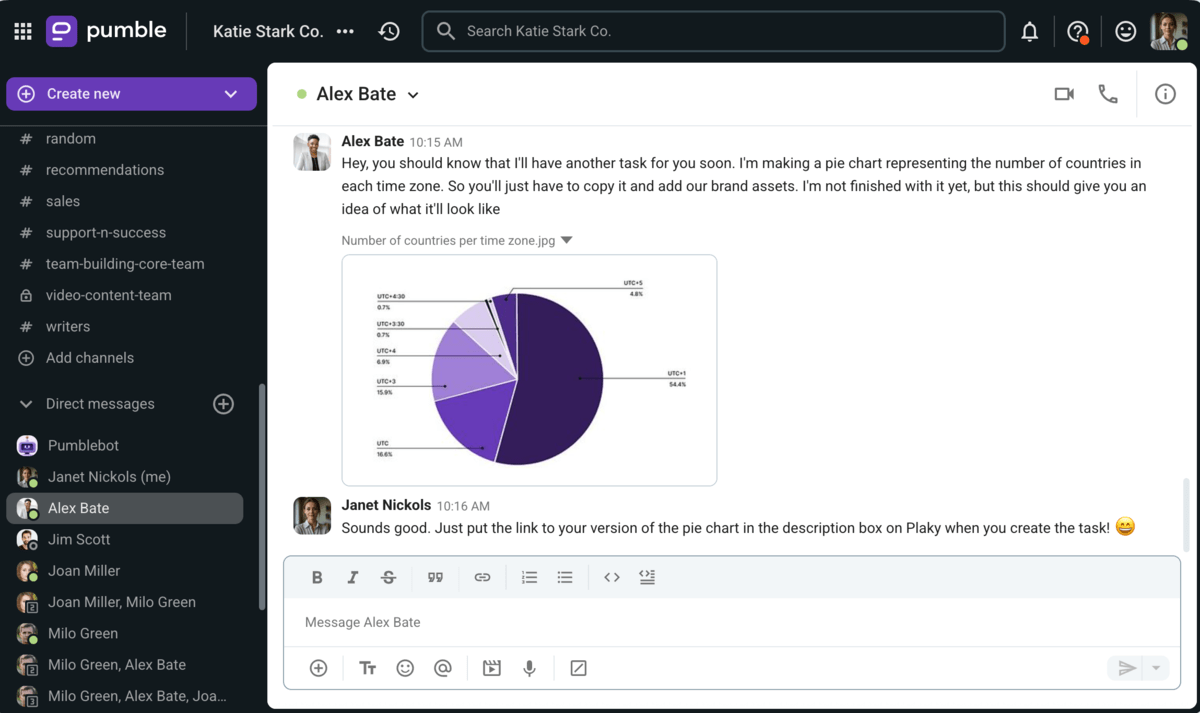
Ejemplo de diagrama de flujo
Al crear un diagrama de flujo, las personas suelen utilizar cuadros para representar los diferentes pasos de un proceso. Los cuadros, es decir, los escalones, suelen estar conectados con flechas o líneas.
En el siguiente ejemplo, un especialista junior en adquisición de talentos de un equipo de recursos humanos tiene la tarea de planificar mejoras en el proceso de contratación.
Planifica estos mejoramientos a través de un diagrama de flujo que incluye los siguientes cajas conectadas:
- “¿Dónde nos encontramos ahora?”
- “¿Qué queremos lograr?”
- “¿Cómo vamos a lograrlo?”
- “¿Cómo sabremos que lo hemos logrado?”
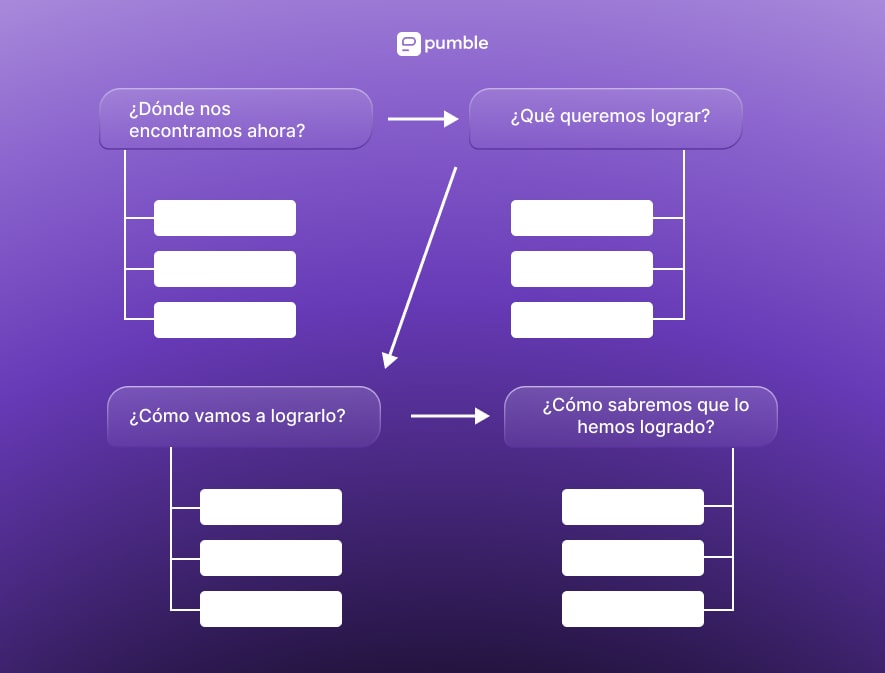
Ejemplo de infografía
Las infografías son una herramienta útil cuando se busca una forma sencilla, pero visualmente atractiva y llamativa de mostrar estadísticas, explicar conceptos, describir un proceso, comparar productos u organizar la información.
En el siguiente ejemplo, un psicólogo escolar crea una infografía sobre la motivación que resume varias teorías relevantes (como la jerarquía de necesidades de Maslow).
La cuelgan en la pared de la sala de profesores para ayudar a sus colegas a mantener altos sus niveles de motivación durante su trabajo.
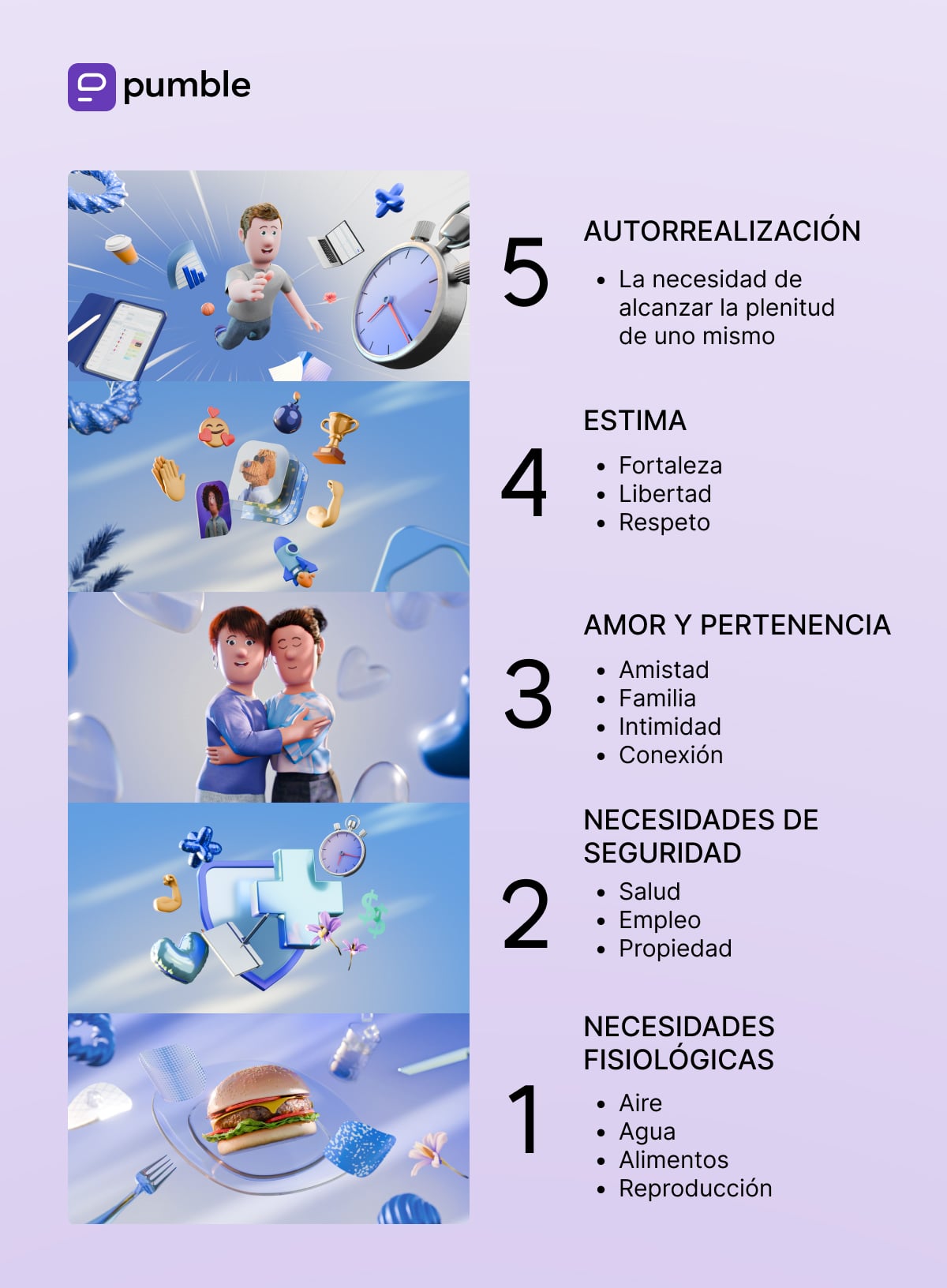
Ejemplo de diapositiva de presentación
Típicamente, el presentador, o alguna persona de su equipo, comenzará el proceso de crear una presentación recopilando la información que quiere transmitir.
Luego, usará estos datos para crear dispositivos que constan de una cantidad moderada de texto, diagramas, gráficos, imágenes y otras representaciones visuales de datos.
Puesto que las presentaciones son un método bastante común de transmitir información en el lugar de trabajo moderno, muchas empresas tienen plantillas de marca disponibles para empleados quienes a menudo son llamados a presentar.
Aunque no es obligatorio, la mayoría de las presentaciones terminan con referencias, “gracias”, agradecimientos y llamadas a la acción.

Ejemplo de mapa de ruta
Las hojas de ruta incluyen los pasos a seguir y los hitos que se deben alcanzar para que tus esfuerzos sean un éxito. Muestran el camino desde la planificación hasta el lanzamiento exitoso de la aplicación que estás desarrollando.
En nuestro ejemplo, mostramos la hoja de ruta, de Pumble, que permite a los clientes mantenerse al tanto de las actualizaciones de sus productos.
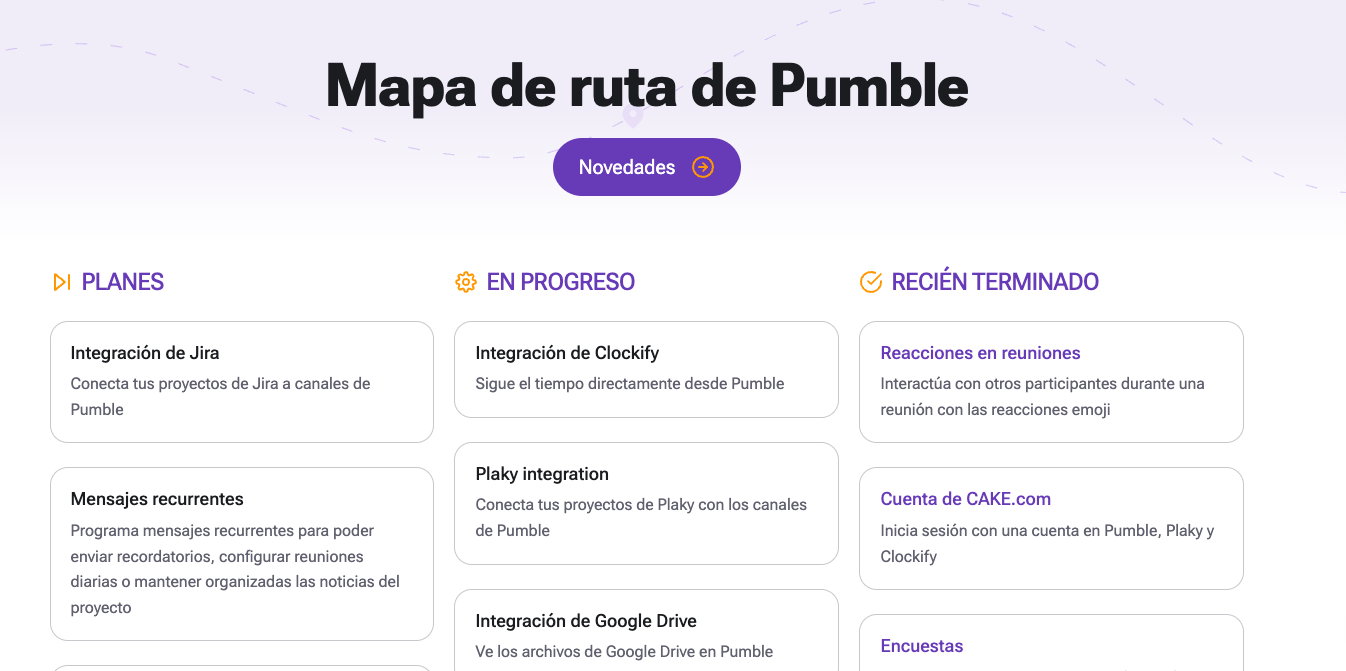
Establece y logra objetivos de negocio con Pumble
Consejos para una comunicación visual mejor
Para concluir este capítulo, veamos qué hacer y qué no hacer con los diferentes medios de comunicación visual.
| Medios de comunicación visual: | Lo que deberías hacer: | Lo que no deberías hacer: |
|---|---|---|
| Imágenes | – Elegir el estilo y el formato adecuados – Elegir la paleta de colores adecuada | – Sobrecargar tus presentaciones con demasiadas imágenes (perderán su importancia) |
| Vídeos | – Que tengan la duración perfecta para su contexto (presentación empresarial, video educativo, documental breve independiente o similar) – Que sean dinámicos e interesantes | – Hacerlos demasiado largos – Crear vídeos en un formato inadecuado para la aplicación |
| Gráficos de datos | – Que sean fáciles de entender – Que sean visualmente atractivos y acordes con tu empresa o equipo | – Dificultar la lectura – Incluir demasiados datos |
| Diagramas de flujo | – Centrarte en los pasos más importantes que quieres destacar – Crear títulos y descripciones breves y efectivos | – Incluir demasiados pasos – Incluir demasiadas líneas de texto |
| Mapas de ruta | – Dividir los próximos hitos frente a los recién finalizados o los que se encuentran en la etapa de "idea"
– Describir los hitos de forma breve y eficaz | – Hacer que lo visual sea confuso – Hacer que las descripciones de los hitos sean demasiado detalladas |
| Mapas mentales | – Crear un tema central claro – Crear ramas basadas en el proceso de pensamiento o la relevancia para el tema central | – Pasar por alto el tema central
– Encadenar términos arbitrariamente sin pensarlo mucho |
| Infografías | – Resumir brevemente la información importante – Elegir la composición adecuada para el elemento visual | – Incluir muy pocos o demasiados detalles – Crear una imagen desequilibrada (demasiado texto o demasiados elementos visuales) |
| Diapositivas de presentación | – Considerar tu presentación como un delicado equilibrio entre los elementos escritos, mostrados y hablados | – Extender las oraciones de las diapositivas más de lo necesario – Sobrecargar tus diapositivas con muchos elementos |
| Informes visuales | – Incluir mejoras visuales (color de resaltado, bloques de color, otros motivos visuales) – Crear una jerarquía de texto clara para facilitar la navegación | – Rellenar los formularios con elementos de diseño innecesarios – Usar tipografías informales |
| Ayudas visuales impresas | – Incluir información adicional que tenga un valor único en el contexto | – Repetir la misma información |
Otros tipos de comunicación
Habiendo cubierto los 4 tipos principales de comunicación, echemos un vistazo a otras formas de comunicación y comprendamos sus diferencias.
Comunicación en línea vs. fuera de línea
Con la emergencia del internet y varias tecnologías de acompañamiento, ha surgido otra clasificación importante de las formas de comunicación: comunicación en línea y comunicación fuera de línea.
Hoy en día, la mayoría de las personas se comunican y forman vínculos sociales usando una combinación de estos dos modelos de comunicación.
Sin embargo, las implicaciones de un modelo de comunicación tan mixto en nuestras interacciones sociales todavía no se entienden completamente.
Según las Estadísticas de trabajo remoto para 2025 de Pumble, casi el 46% de los gerentes de proyectos encuestados citaron la falta de comunicación como el mayor desafío en la gestión del trabajo remoto.
En otra encuesta, el 71% de los encuestados estuvo de acuerdo en que construir y mantener relaciones era uno de los mayores desafíos para los equipos virtuales.
Sin embargo, los modelos de comunicación mixtos también tienen numerosos aspectos positivos.
Beneficios de la comunicación en línea en el trabajo
Aunque la comunicación en línea podría tener potencial disruptivo para las relaciones personales, en el lugar de trabajo, las herramientas de comunicación en línea mejoran en gran medida la comunicación dentro de la organización.
Las nuevas tecnologías han simplificado el intercambio de información con clientes y terceros. Según las Estadísticas del trabajo remoto, el 98% de los encuestados afirmó que trabajaría de forma remota, al menos parte del tiempo, durante el resto de su carrera profesional.
Otra estadística señala que los cuatro beneficios más comunes para los empleados de la Generación Z y los Millennials que trabajan de forma remota son:
- Mejor equilibrio entre la vida laboral y personal,
- Ahorro de dinero,
- Mayor productividad, e
- Impacto positivo en la salud mental.
Otros beneficios notables de la comunicación en línea incluyen:
- Una comunicación asincrónica mucho más sencilla en diferentes zonas horarias,
- Recordatorio y transcripción de reuniones virtuales, y
- Asignación de procesos de forma mucho más eficiente y a varios miembros del equipo simultáneamente.
Ve un ejemplo de comunicación asincrónica exitosa en Pumble:
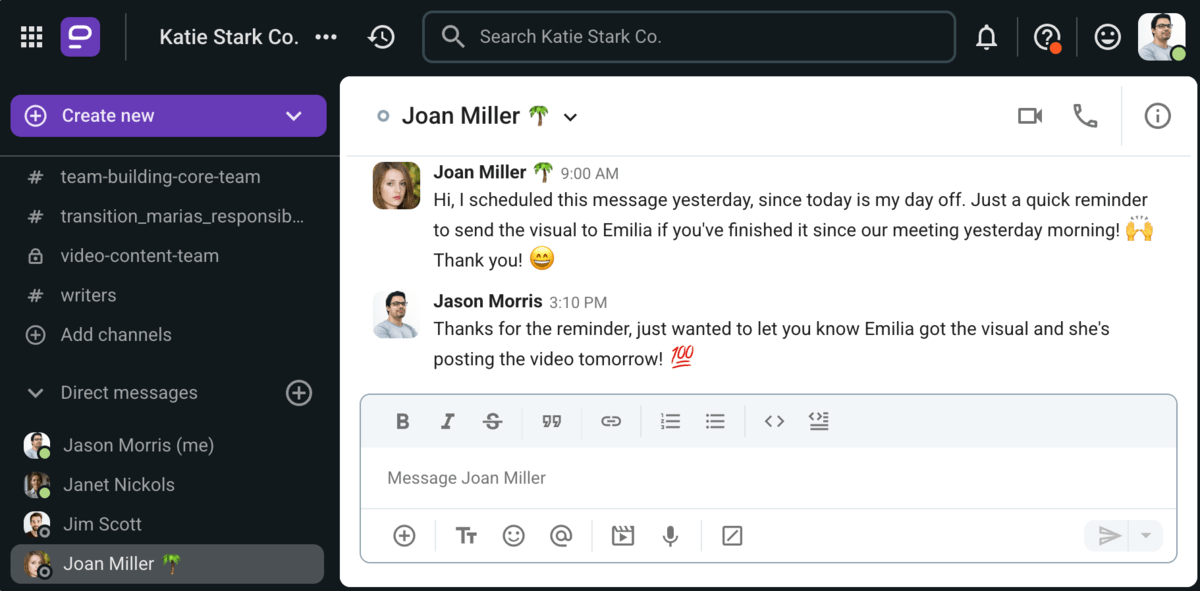
Simplifica la comunicación en equipo con Pumble
Tipos de comunicación según la jerarquía
Tras describir los diferentes tipos de comunicación que podemos utilizar, así como la respuesta adecuada que requieren, es hora de examinar cómo nuestras relaciones profesionales con nuestros interlocutores afectan a nuestros intercambios.
Desde esta perspectiva, existen cuatro tipos de comunicación en una empresa:
- Comunicación ascendente — los subordinados se comunican con sus superiores. Se refiere tanto a la comunicación individual como al sentimiento general de los empleados. Suele basarse en formularios, encuestas, informes y otros métodos similares para transmitir la información.
- Comunicación descendente — los superiores se comunican con los subordinados. Se utiliza principalmente para transmitir nueva información, dar instrucciones, delegar tareas, etc.
- Comunicación lateral — intercambios entre empleados o departamentos del mismo rango o estatus. Puede ocurrir individual o en grupo, tanto verbalmente como por escrito.
- Comunicación externa — una organización que se comunica con partes externas, como clientes, socios, vendedores, proveedores, entidades legales, medios de comunicación y el público en general. Este tipo de comunicación requiere una consideración cuidadosa de cualquier posible malentendido, ya sea un anuncio u otro tipo de mensaje externo.
🎓 Consejo Pro de Pumble
Para que una comunicación externa sea exitosa, una organización primero debe establecer una comunicación interna impecable. Si te resulta difícil alcanzarla, te recomendamos consultar el siguiente artículo:
Utiliza diferentes tipos de comunicación con Pumble
Explorar los diferentes tipos de comunicación revela la amplia gama de herramientas y plataformas a tu disposición. Desde interacciones presenciales hasta mensajería asincrónica, las diferentes formas de comunicación ofrecen ventajas únicas y se adaptan a diferentes necesidades y preferencias.
Al explorar este diverso panorama, es fundamental incorporar herramientas de mensajería como Pumble.
Pumble es una aplicación versátil de comunicación en equipo que fomenta la colaboración fluida entre los miembros del equipo.
Ya sea para generar ideas o para comunicarse sobre tareas compartidas, Pumble facilita flujos de trabajo eficientes, actuando como una sede digital para ti y tu equipo.
Utiliza sus mensajes directos, canales privados y públicos, intercambio de archivos, videollamadas y mucho más para perfeccionar todos los tipos de comunicación que utilizas en tu trabajo.
Mejora la productividad y la colaboración, y en definitiva, mejora tus esfuerzos de comunicación.
Descubre cómo Pumble puede mejorar la comunicación de tu equipo.
Cómo revisamos esta publicación: Nuestros escritores y editores monitorean las publicaciones y las actualizan cuando hay nueva información disponible, para mantenerlas frescas y relevantes.


